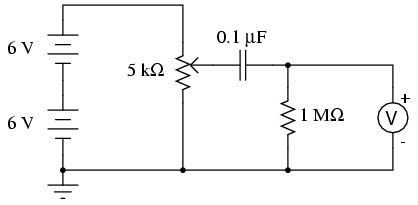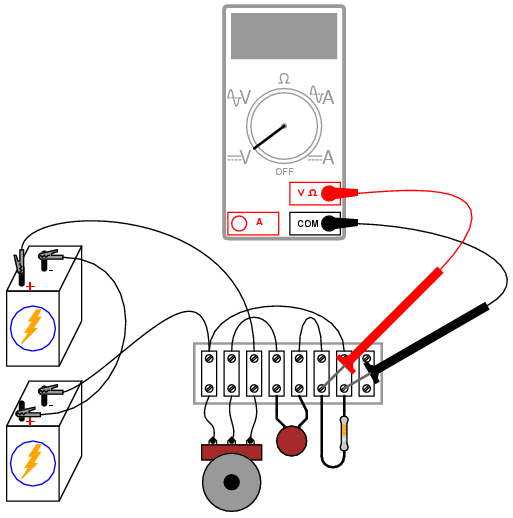Rate-of-change indicator
PARTS AND MATERIALS
-
Two 6 volt batteries
-
Capacitor, 0.1 �F (Radio Shack catalog #
272-135)
-
1 MΩ resistor
-
Potentiometer, single turn, 5 kΩ, linear
taper (Radio Shack catalog # 271-1714)
The potentiometer value is not especially
critical, although lower-resistance units will, in theory,
work better for this experiment than high-resistance units.
I've used a 10 kΩ potentiometer for this circuit with
excellent results.
CROSS-REFERENCES
Lessons In Electric Circuits, Volume
1, chapter 13: "Capacitors"
LEARNING OBJECTIVES
SCHEMATIC DIAGRAM

ILLUSTRATION

INSTRUCTIONS
Measure voltage between the potentiometer's
wiper terminal and the "ground" point shown in the schematic
diagram (the negative terminal of the lower 6-volt battery).
This is the input voltage for the circuit, and you can see
how it smoothly varies between zero and 12 volts as the
potentiometer control is turned full-range. Since the
potentiometer is used here as a voltage divider, this
behavior should be unsurprising to you.
Now, measure voltage across the 1 MΩ
resistor while moving the potentiometer control. A digital
voltmeter is highly recommended, and I advise setting it to
a very sensitive (millivolt) range to obtain the strongest
indications. What does the voltmeter indicate while the
potentiometer is not being moved? Turn the
potentiometer slowly clockwise and note the voltmeter's
indication. Turn the potentiometer slowly counter-clockwise
and note the voltmeter's indication. What difference do you
see between the two different directions of potentiometer
control motion?
Try moving the potentiometer in such a way
that the voltmeter gives a steady, small indication. What
kind of potentiometer motion provides the steadiest
voltage across the 1 MΩ resistor?
In calculus, a function representing the
rate of change of one variable as compared to another is
called the derivative. This simple circuit
illustrates the concept of the derivative by producing an
output voltage proportional to the input voltage's rate
of change over time. Because this circuit performs the
calculus function of differentiation with respect to time
(outputting the time-derivative of an incoming signal), it
is called a differentiator circuit.
Like the averager circuit shown
earlier in this chapter, the differentiator circuit is a
kind of analog computer. Differentiation is a far more
complex mathematical function than averaging, especially
when implemented in a digital computer, so this circuit is
an excellent demonstration of the elegance of analog
circuitry in performing mathematical computations.
More accurate differentiator circuits may be
built by combining resistor-capacitor networks with
electronic amplifier circuits. For more detail on
computational circuitry, go to the "Analog Integrated
Circuits" chapter in this Experiments volume. |